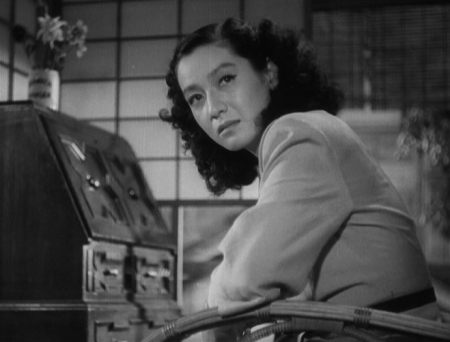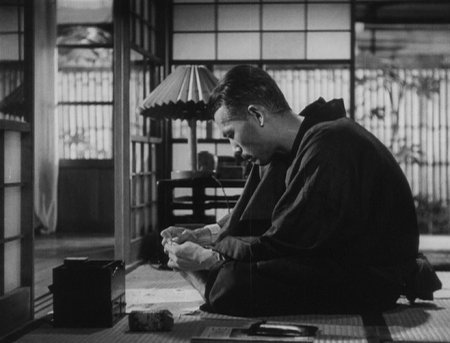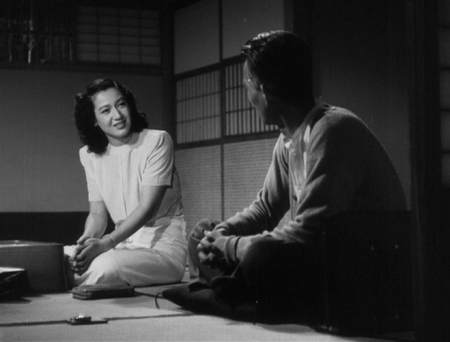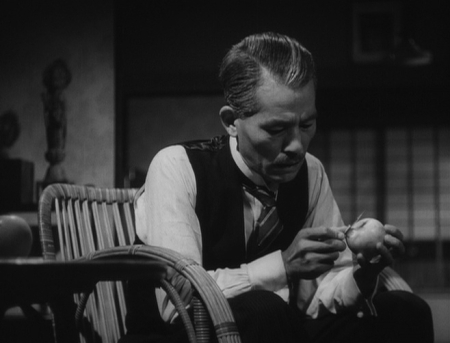
“I always tell people that I don’t make anything besides tofu, and that is because I am strictly a tofu-dealer,” Yasujirô Ozu said of his work while promoting An Autumn Afternoon, the 1962 film that would turn out to be his swan song. (He died of cancer the following year, on his sixtieth birthday.) By that point, he had been directing for thirty-five years. Although his resume includes college comedies, crime dramas, a period piece (his now-lost debut, Sword of Penitence) and a documentary short on a kabuki dancer, the bulk of his impressive output — fifty-four films in total, despite the fact that his career was interrupted in the late 1930s and again in the early to mid-1940s when he was called up for military service — deals with family relationships in contemporary Japan. Tokyo Story, released in 1953, is probably the best-known example, a tale about an elderly couple traveling to the titular city to visit their children and grandchildren. However, the most representative entry in Ozu’s filmography — his tofu in its purest form, as it were — may be 1949’s Late Spring.
The film tells the story of Noriko Somiya (Setsuko Hara), a young woman who lives outside of Tokyo with her widowed professor father, Shukichi (Chishû Ryû). The two lead a peaceful, happy existence together and would be perfectly content to go on in this way, but Noriko’s aunt (Haruko Sugimura) thinks it’s high time for her twenty-seven-year-old niece to get married and leave home. She’s even picked out a potential husband for Noriko, a man named Satake who works at a chemical company. Noriko isn’t interested, in part because she fears that her father — intelligent and able-bodied, yet completely dependent on his daughter in many ways — would be lost without her. However, she soon comes to believe that Shukichi intends to remarry, and this distasteful discovery makes her reconsider her position and her future.

Late Spring is unmistakably an Ozu movie. Its style alone gives it away immediately: the static camerawork (with a few exceptions, including a tracking shot along a beach when Noriko and her father’s assistant go cycling), the low placement of the camera, the tendency for the actors to face the viewer head-on during conversations. The subject matter, too, is classic Ozu. He and frequent co-writer Kôgo Noda would reuse the same basic story in 1960’s Late Autumn, albeit with some additions and alterations — one being that the widowed parent in the later film is a mother, portrayed by Setsuko Hara. Additionally, Early Summer (1951), Equinox Flower (1958) and An Autumn Afternoon all revolve around families with single daughters considering marriage (the last is particularly close to Late Spring, although it focuses more on the father, once again played by Chishû Ryû), and the film’s themes — marriage, yes, but the parent-child relationship even more so — are present in one form or another throughout his oeuvre.
That said, whatever similarities, superficial and otherwise, may exist among Ozu’s films, each one has something unique to offer, and Late Spring is no exception. Although it would prove viable as a template for Late Autumn and An Autumn Afternoon over a decade later, it’s also very much a product of the time in which it was made, only a few years after the end of World War II. It was Ozu’s third postwar movie, following 1947’s Record of a Tenement Gentlemen and 1948’s A Hen in the Wind. Both of these films concern characters struggling with the direct effects and aftereffects of the war, including supply shortages, inflation and the break-up of families. In contrast, Late Spring shows a Japan emerging from these shadows, though recent hardships remain vivid memories even to comfortably middle-class citizens like the Somiyas. One reason why Noriko hasn’t seriously considered marriage before this point is that she’s been suffering from poor health, the result of forced labor during the war; the fact that she’s “looking much healthier” now can certainly be read as a comment on the nation as a whole. Also relevant is a scene in which Noriko’s aunt criticizes a bride for eating voraciously and drinking sake at her wedding. “Of course she ate. Food was scarce for so long,” Shukichi says, and when the aunt recalls that she was too filled with gratitude at her own wedding to consume a single rice ball, he replies, “If it were today, you’d eat plenty.”

Times are changing, as evidenced by the Westernization woven into this world. To be sure, the influence of Western culture is present in Ozu’s films as far back as the 1920s, not least of all in his cinematic influences (he greatly admired Ernst Lubitsch, for example, and 1934’s A Story of Floating Weeds was based on a 1928 American film called The Barker), but it’s especially noteworthy in this postwar context. Baseball is seen and mentioned several times: Noriko’s divorced friend Aya (Yumeji Tsukioka) uses the sport as a metaphor for her own attitude toward marriage, and Noriko’s aunt tells her that Satake “looks like that American, the man in that baseball movie” — Gary Cooper. (“Looks just like him,” she says. “He has the exact same mouth. The top half is different, though.”) The cycling scene, meanwhile, features a prominent advertisement for Coca-Cola — entirely in English, no less — along the side of an otherwise uncommercialized road. In an essay on Late Spring entitled “Home with Ozu,” Michael Atkinson wonders, “Was Ozu the first filmmaker to use the Coca-Cola logo as a symbol for rampaging Yankee capitalism? He certainly beat Jean-Luc Godard and Billy Wilder to the punch,” alluding to Godard’s Masculin féminin (1966) and Wilder’s One, Two, Three (1961).
If the youths of Masculin féminin are the children of Marx and Coca-Cola, as a famous intertitle describes them, then perhaps Noriko could be called the child of an equally uneasy union between Coca-Cola and Japanese tradition. (Notably, Japan was still under American occupation in 1949. When the first script for the film was submitted, the American censors objected to the subject of arranged marriage, which they considered feudalistic and anti-individualistic. Fortunately for Ozu, they ended up permitting it in the final version.) Contrasts abound in Late Spring: East and West, the old and the new, the sublime and the prosaic. The film opens with Noriko and her aunt attending a tea ceremony, but their conversation as they wait for it to begin is about moth-eaten trousers, and the incongruities continue from there. Ozu is just as apt to show a train or a modern office building as a mountain or a temple, as apt to send his characters to a violin concert as to a Noh play; there’s even a scene of Shukichi clipping his toenails, an act that transcends any cultural or geographical divisions in its utter mundanity.

And yet, regardless of these conflicting elements and the recent war, Late Spring is a largely tranquil film — at least on its surface. “Rather than tell a superficial story, I wanted to go deeper, to show the hidden undercurrents, the ever-changing uncertainties of life. So instead of constantly pushing dramatic action to the fore, I left empty spaces, so viewers could have a pleasant aftertaste to savor,” Ozu once said, quoted in the 1983 documentary I Lived, But… As is typical of his work, Late Spring often avoids or skips over expected, would-be crucial scenes, such as Noriko’s first meeting with Satake. In fact, Satake never appears onscreen at all. He serves as a sort of MacGuffin, giving the plot, such as it is, an impetus without being of any real importance in and of himself (even if he does have a mouth exactly like Gary Cooper’s). According to Donald Richie’s book Ozu, the director “sometimes maintained that romantic love did not really interest him, implying that he was interested only in love between members of a family.” Noriko could be leaving home for a job or an education instead of marriage, though marriage is the most likely option in her time, place and circumstances; what matters is that she and her father will no longer be living together as they have been.
Much like Satake, Shukichi’s late wife is a shadowy figure, rarely mentioned, but it’s clear that Noriko has taken on and even embraced the housewife role in her mother’s absence. She serves her father his dinner, picks up the coat that he drops on the floor, brings him a towel so that he can wash up at the sink. Although he’s accustomed to this treatment and sometimes comes across as a bit bossy, he’s no ogre; when Aya comes over to visit Noriko, for instance, Shukichi prepares a tray of bread and tea for the young women (and forgets the sugar and the spoons, much to Noriko’s amusement). Moreover, there’s a great deal of love and affection between them, and until the marriage issue arises, Noriko seems perpetually cheerful, always smiling and laughing. “I want us to stay as we are,” she confesses to Shukichi. “I don’t want to go anywhere. Being with you is enough for me. I’m happy just as I am. Even marriage couldn’t make me any happier. I’m content with this life.”

But her father insists that it’s time for for her to start a new life, without him. “That’s the order of human life and history,” he says. Perhaps he’s right; perhaps marrying Satake will allow her to gain some independence, to establish a future for herself, to learn to exist on her own terms and apart from her father, which she’ll have to do at some point anyway. Change is inevitable, both in the wider world and in the peaceful home that, no doubt, has been a refuge to Noriko in tumultuous times. Still, no matter what its benefits, it’s a painful experience for her. Apart from her reluctance to leave her father alone, it’s only natural that she would resist giving up her current contentment for something unknown and uncertain. Marriage, as she realizes, is no guarantee of happiness. The cheerily pessimistic Aya, who married for love and came to regret it, nonetheless urges her friend to give it a try. “If he’s no good, leave him. It’s simple, I tell you,” she says. Shukichi, on the other hand, explains to his daughter that a successful marriage requires work: “Happiness isn’t something you wait around for. It’s something you create yourself.” He does whatever he can to make it easier for Noriko to move on, believing that that’s what’s best for her — yet the separation hurts him as much as it hurts her. “It’s pointless to have a daughter,” he remarks to a friend, an obvious attempt to bury his pain under cynicism.
Another Chishû Ryû character would make the same comment for the same reason thirteen years later in An Autumn Afternoon. Ryû was a ubiquitous presence in Ozu’s work, beginning with bit parts in the silent era and working his way up to leading roles, often as a father or grandfather. By comparison, Setsuko Hara’s six-film collaboration with the director may appear minor, but there’s little question that she’s the actress most closely associated with Ozu. Late Spring was their first film together; the next, Early Summer, also has her portraying a young woman named Noriko being pressured into marriage. (She played a Noriko in Tokyo Story as well, and the three movies are sometimes referred to as the Noriko trilogy.) However, this second Noriko is more proactive than the first, choosing her own husband, and like most of the single women in Ozu’s later films, she works outside of the home. By the time of Late Autumn and The End of Summer (1961), Hara was playing widows, now being urged to remarry. Although, paradoxically, she’s traded her Western clothing for traditional kimonos in these roles, she’s more self-sufficient than ever before: when she, like Noriko, says that she’s fine as she is, she sticks to it — even if, like Shukichi, she has to pay for it with loneliness.

Because Ozu specialized in family relationships and because his style is so consistent, there’s a certain comfortable sameness to his films on a superficial level. Within this fairly narrow framework, though, he touched on everything from adultery (most notably in 1956’s Early Spring) to parental abandonment (in 1957’s Tokyo Twilight) to flatulence jokes (in the 1959 comedy Good Morning), not to mention coming up with numerous variations on the theme of daughters reaching marriageable age. One of his most significant assets as a director is what’s beneath the surface of all of his films: emotions to which every viewer can relate, subdued though they may be on the screen. Late Spring is a product of the time and place in which it was made, undoubtedly, but at heart, it’s a simple story about a parent and a child — simple yet simultaneously complicated, and universal.
Sources
Atkinson, Michael. “Home with Ozu.” Liner Notes. Late Spring. The Criterion Collection, 2006.
Hirano, Kyoko. Mr. Smith Goes to Tokyo: Japanese Cinema under the American Occupation, 1945-1952. Washington: Smithsonian, 1992.
I Lived, But… Dir. Kazuo Inoue. Shochiku, 1983.
Richie, Donald. Ozu. Berkeley: University of California, 1974.
This post is part of The Favorite Director Blogathon, hosted by The Midnite Drive-In and Phyllis Loves Classic Movies. Click the banner above to see all of the other great posts.


Have to admit, aside from Kurosawa and Ishiro Honda (of Godzilla fame) I’ve never seen much in the way of Japanese films. I’ll look to see if my library has this, though. Good review. Thanks for joining our blogathon.
LikeLiked by 1 person
Thank you, and thanks for hosting!
LikeLike
I liked your line about Ozu’s consistency and familiar sameness. We travel a well-worn road, yet depending on our own emotional level while watching the films, we may arrive at a different place.
LikeLiked by 1 person
Thank you! I’ve seen a lot of his movies many times, but I always seem to get something new out of them, however minor.
LikeLike
The only “foreign” films I’ve seen are British ones but, given that there is usually someone who writes about an Ozu film, and after reading this thoroughly fascinating post, I think I’ll have to give him a try. I’m definitely drawn to the look of this film and the titles Ozu used.
Thanks so much for participating in the blogathon!
LikeLiked by 1 person
You’re welcome, and thank you for hosting! If you’re interested in Ozu, Late Spring is a great place to start.
LikeLike
Bravo, Erin! This was a fantastic article.
Late Spring was my first Ozu, and I instantly fell in love with his filmmaking. It is, indeed, a complx and universal story. I loved your analysis.
Kisses!
Le
LikeLiked by 1 person
Thanks so much!
LikeLike
Excellent review, Erin. I say this a lot, but you always give increase my appreciation for certain films, and your writing is precise, meticulous and wonderful as always.
LikeLiked by 1 person
Thanks so much! I really appreciate the kind words.
LikeLiked by 1 person
Great post, you approach the main themes with great patience and care. Love the film, my favourite in Ozu’s filmography.
LikeLiked by 1 person
Thank you! It’s my favorite too.
LikeLiked by 1 person
Pingback: Nationality and the Female Experience in Yasujirō Ozu’s Late Spring – The Sundial